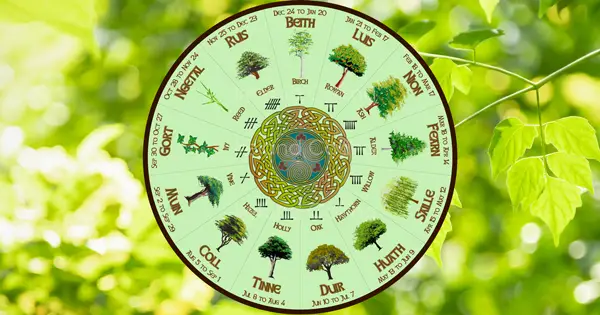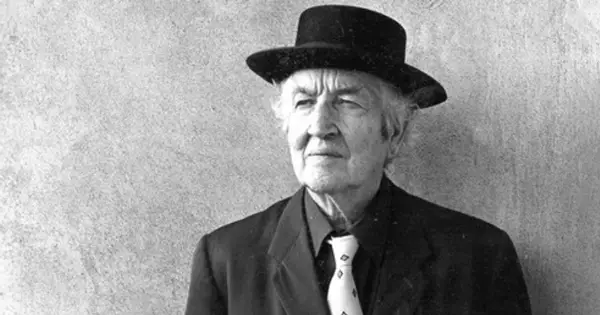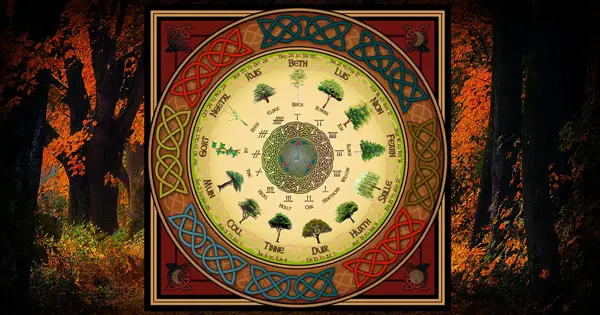The Celtic Tree Calendar finds its roots in the ancient Celtic culture, where trees were regarded as living beings with deep spiritual significance. The calendar is based on the Ogham alphabet and consists of thirteen lunar months, corresponding to a particular tree. The Celtic people believed that each tree possessed unique qualities, characteristics, and energy that influenced the human experience.
Roman accounts back up the theory that the Druids, the spiritual leaders of Celtic culture, followed a lunar calendar rather than the solar Gregorian calendar we know today. Each month was 28 days with one extra day representing the 23rd December, the ‘Day of Creation’.

Each of the 13 months is represented by a tree together with its ogham letter.
The Creator: Robert Graves (1895-1985)

The calendar was conceived by the British poet and scholar Robert Graves. It was an idea put forward in his book The White Goddess, a historical grammar of poetic myth, first published in 1948.
The book focused on the mythology of Ireland, Britain, Europe and the Middle East, interpreting it in Grave’s individual and poetic style.
The Ogham trees and their meanings

Graves drew inspiration from the traditional Ogham script and assigned each lunar month to a specific Ogham tree. The Ogham Tree Calendar comprises a pantheon of enchanting trees, each carrying its own symbolism and mystical qualities:
- Birch (Beith): Signifies new beginnings, purification and growth. It represents the transformative power of change and invites us to embrace fresh starts.
- Rowan (Luis): Symbolizes protection, intuition, and spiritual insight. The Rowan tree is associated with warding off negative energies.
- Ash (Nion): Represents harmony, balance, and connection. The Ash tree embodies strength and resilience while fostering a sense of unity with the world around us.
- Alder (Fearn): Signifies protection, courage, and inner strength. The Alder tree offers support during challenging times and encourages us to face our fears with bravery.
- Willow (Saille): Symbolizes intuition, emotions, and flexibility. The Willow tree reminds us to trust our instincts and adapt to life’s ever-changing circumstances.
- Hawthorn (Huath): Represents love, fertility, and protection. The Hawthorn tree is associated with matters of the heart, both romantic and spiritual, and offers a shield against negative influences.
- Oak (Duir): Symbolizes strength, endurance, and wisdom. The Oak tree is revered as a sacred tree, embodying the connection between humans and the divine, and reminding us of our inner strength and the importance of wisdom in our lives.
- Holly (Tinne): Signifies protection, resilience, and spiritual strength. The Holly tree is associated with overcoming obstacles.
- Hazel (Coll): Represents inspiration, knowledge, and creativity. The Hazel tree is associated with wisdom and the pursuit of poetic imagination, urging us to seek inspiration from unexpected sources.
- Vine (Muin): Symbolizes joy, celebration, and abundance. The Vine tree encourages us to indulge in life’s pleasures, fostering a sense of joy and the celebration of abundance in all its forms.
- Ivy (Gort): Signifies adaptability, transformation, and connection. Gracefully intertwining and adapting to its surroundings, the Ivy tree teaches us the importance of resilience and the unity of all things.
- Reed (Ngetal): Represents protection, reflection, and inner work. The Reed tree symbolizes the need for introspection, encouraging us to delve deep into our emotions and navigate the waters of self-discovery.
- Elder (Ruis): Symbolizes healing, transformation, and wisdom. The Elder tree is associated with the passage of time and the cycles of life, offering guidance and the potential for spiritual growth.
Ancient Influences on the tree calendar

As historical accounts of ancient Druids are scarce, many of Graves’ ideas regarding the Celtic Tree Calendar were based on the works of Irish historian and genealogist Ruaidhrí Ó Flaithbheartaigh, (Roderick O’Flaherty). Ó Flaithbheartaigh had published Ogygia in 1685, an elaborate history of Ireland that journeys back to the time of myths and legends and contains within it a chapter on understanding the ancient Ogham alphabet.
Ogham was an ancient Celtic writing system consisting of a series of vertical and diagonal lines. Ó Flaithbheartaigh’s meticulous research and appreciation for ancient Irish traditions added depth and authenticity to the poetic tapestry woven by Graves.
Graves’ works may also have been influenced by the 14th century Book of Ballymote which contains a chapter on the ogham in which many varieties of the alphabet appear in the form of several diagrams thought to be used as secret codes.

Calendar is woven in Celtic mythology
Although the calendar is quite new in a historical sense, its influences lie within ancient Celtic mythology and folklore. It intertwines nature, myth, and symbolism, offering a deeper understanding of the natural world and our place within it.
By recognising the significance of each tree, we can gain insights, find inspiration, and align our lives with the rhythms of nature.
Whether we simply appreciate the beauty of the calendar or delve deeper into its symbolism, the Ogham Tree Calendar invites us to cultivate a profound connection with nature and embrace the wisdom it holds. It is a beautiful example of how modern spiritual beliefs and the customs of ancient times can be combined to form something enchanting.
Incorporating the Celtic Tree Calendar into daily life
The Ogham Tree Calendar extends beyond symbolism, offering practical applications that enrich our lives. These fun and creative ways of incorporating it into daily life can deepen your connection with nature, enhance your understanding of tree symbolism, and infuse your routine with the wisdom and energy of the trees throughout the year:
- Nature Walks: Take regular nature walks and make it a fun challenge to identify and connect with the trees associated with each month of the calendar. Learn their names, observe their characteristics, and reflect on the symbolism they represent.

- Create Tree-Inspired Art: Use the symbols and characteristics of the trees from the Celtic Tree Calendar as inspiration for your artwork. Paint or draw the trees, create tree-themed crafts or design your own tree-inspired jewellery.

- Tree Meditation: Practice tree meditation by sitting or standing near a tree associated with the current month. Close your eyes, focus on your breathing, and imagine yourself connecting with the energy and wisdom of the tree.

- Tree Planting: Celebrate the beginning of each month by planting a tree associated with that month’s tree in your garden or a local community space. This act symbolizes growth, renewal, and a deeper connection with nature.

- Tree-Based Recipes: Explore culinary delights inspired by the Celtic Tree Calendar. Incorporate ingredients associated with specific trees into your recipes. For example, use hazelnuts for Hazel month or apples for Apple month.

- Tree Journaling: Maintain a tree journal where you record your observations, thoughts, and experiences related to the trees. Write about the symbolism, personal reflections, and any connections you feel with the specific trees throughout the year.

- Tree Reading List: Create a reading list featuring books that explore the symbolism and mythology of trees, Celtic folklore, or nature-based spirituality. Dive into these books and expand your knowledge about the trees and their significance.

- Tree-inspired Gardening: Design a garden or a special section within your garden that includes the trees associated with the Celtic Tree Calendar. Create a sacred space where you can connect with the natural world and the energies of the trees.

- Tree-based Crafts: Engage in craft activities using materials from the trees. Create wreaths, dream catchers, or jewellery using branches, leaves, or other natural elements associated with specific trees.

Tree of Life in Celtic Mythology
